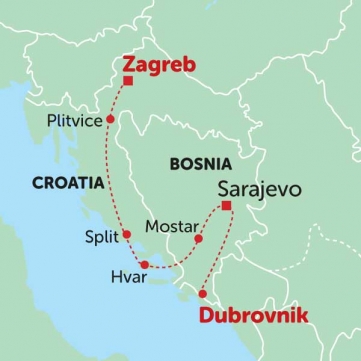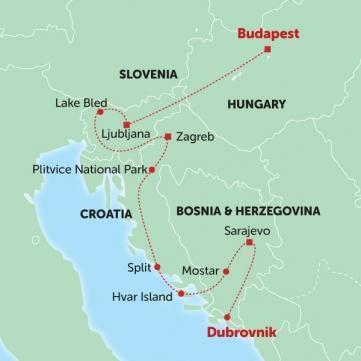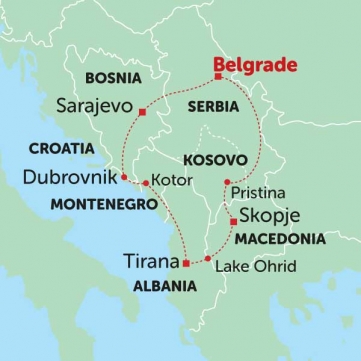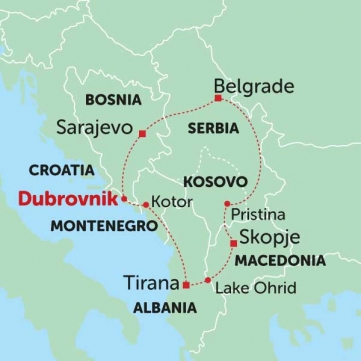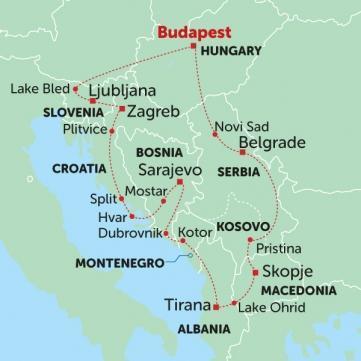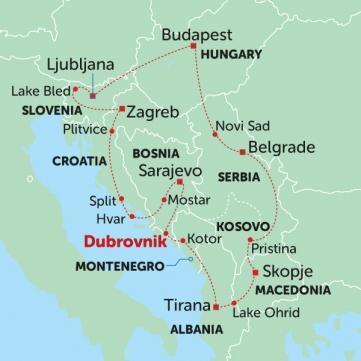Book NOW for $1 £1 €1 • Flexible Payments • No Change Fees • Private Departures Available
- Home >>
- Destinations >>
- Europe >>
- Bosnia & Herzegovina
Bosnia and Herzegovina Tours
Our Bosnia and Herzegovina adventure tours explore this heart-shaped state which sits at the cultural crossroads of East and West and is an excellent place to start any trip in Eastern Europe. Over the centuries a sequence of great empires has ruled here. Formerly part of socialist Yugoslavia, it gained its independence in the Yugoslav wars of the 1990s and scars of this tumultuous history is still readily apparent, despite the country’s peace and prosperity.
On a Bosnia and Herzegovina adventure tour, you can discover the dynamic capital Sarajevo which is often described as a living museum, with mosques, churches and cathedrals in abundance. During your visit you can see the famous Latin Bridge where fatal events triggering the First World War took place, a library which bears the scars of the three year siege of Yugoslavia in the 1990s, and the fascinating tunnel museum which commemorates the efforts of the resistance during that same period. An ancient bazaar, jangly old trams and aromatic coffee houses add to the city’s charm. Travel to Mostar on a Bosnia and Herzegovina adventure tour and visit the iconic Stari Most old bridge arching over the Neretva River. After being destroyed in the 1990s it was elegantly rebuilt in minute detail to symbolically bring the Muslim-Christian community back together.
All Tours of Bosnia and Herzegovina
7 Tours
Independently Verified Travel Reviews From Past Clients
Bosnia and Herzegovina Travel Guide
Bosnia and Herzegovina Travel Guide
Brief history
Bosnia and Herzegovina has been inhabited since the Neolithic age (around 9500 BC) and has been occupied by the Illyrians, the Romans, the Byzantines and later the Slavs in the medieval period. The Turks dominated during the 400 year-long Ottoman rule of 1463-1868 and reorganised society along class and religious lines. During this period of relative peace and prosperity, Islam became the dominant religion with Orthodox and Catholic Christians in large minorities. Many of the country’s most important architectural achievements were made during this time, including the Stari Most (bridge at Mostar) and Gazi Husrev-Beg Mosque in Sarajevo. During the last 100 years of Ottoman rule, the situation deteriorated with plagues, military failures and revolts, and in 1875 a widespread peasant rebellion lead to the Ottomans succeeding power to the Austro-Hungarian Empire in 1878. The Austro-Hungarian leaders built catholic cathedrals and encouraged a pluralist multi-religious nation, as well as introducing coal mining, railways and other infrastructure. Political unrest rose as Bosnia’s Catholic and Orthodox population started to identify themselves with neighbouring Croatia or Serbia respectively. After a Serb nationalist assassinated the heir to the Austro-Hungarian throne in Sarajevo in 1914 sparking the beginning of World War I, Bosnia and Herzegovina joined the South Slav Kingdom of Serbs, Croats and Slovenes, which became known as Yugoslavia in 1929. Tensions remained over national identities within the kingdom and the map was redrawn many times in an effort to erase traditional geographical divisions between major ethnic groups and formerly separate nations. Yugoslavia was invaded by Germany in 1941 during World War II and Croatia sided with Germany to persecute Croatia’s and Bosnia’s Jewish and Serbian population. Bosnia and Herzegovina declared its independence from the former Yugoslavia on 3 March 1992, which was followed by three years of civil war between Bosnian Serbian forces and Bosnian Muslims as well as between Muslims and Croats. A peace agreement was signed in 1995 and the Federation of Bosnia and Herzegovina was created (Muslim & Croat), alongside the Serb republic Republika Srpska. Parliament has since been centralised in Bosnia and Herzegovina and the country has a democratically elected parliament.
Geography and weather
Often referred to as ‘heart shaped’, Bosnia and Herzegovina share borders with Serbia in the east, Montenegro in the southeast, and Croatia to the north and west. It has a short Adriatic coastline of 20km (12 miles) to the south. Two major rivers to the north (Sava) and east (Drina) shape the countries borders.
Much of the terrain is mountainous and hilly. The climate is variable with moderate continental climatic conditions marked by very cold winters and hot summers. Snowfall can often last until April.
Visit www.weather2travel.com to get an idea of what the weather will be like on your tour.
Visa
A valid passport is required for entry. You should also have a copy of your return ticket if requested. Most nationalities do not require a visa, however visa regulations change frequently so it is important you consult with the embassy prior to travelling to ensure you have the correct visas. In some cases you will be crossing the borders on overnight trains and if you do not have the correct visa you will not be allowed to enter the country and will be asked to leave the train. It is the responsibility of the traveller to obtain all correct visas needed prior to departure. Visa services like www.travcour.com can be very helpful.
Money
Prices quoted in this country dossier are in euro or Konvertibilna Marka (KM) unless otherwise specified.
The monetary unit in Bosnia and Herzegovina is the Konvertibilna Marka (KM). For up to date exchange rates with your own currency visit www.oanda.com or www.xe.com.
Notes come in denominations of KM200, 100, 50, 20, 10, 5 and 1 and 50 feninga. Coins are available in denominations of KM2 and 1, and 50, 20 and 10 feninga. Euro notes (but not coins) are also widely accepted, prices can also be found in euros.
Most major currencies can be exchanged at banks and bureaux de change, however the pound sterling is less popular than the euro and US dollar. Credit cards are widely accepted. Most banks will give cash advances on credit cards with a passport. Cash machines can be found in cities like Sarajevo, Mostar, Banja and Luka. Travellers cheques can be changed in only in selected banks. Carrying cash is advisable.
Tipping
It is customary to give round up the taxi fare and leave an extra 1-2 KM extra at restaurants. (If you are unsure your tour leader will advise a suitable amount). Tipping guides at the end of excursions is always appreciated and your tour leader will advise you on the amount for this.
Local transport
The safety and condition of urban roads in Bosnia and Herzegovina are generally fair, but rural road maintenance is poor. During winter and spring, block ice and landslides can make driving difficult. In Sarajevo you will find a fairly efficient tram network. Tickets are sold from kiosks. One of the most popular and reliable ways of getting around on your own in large cities in is by taxi and Sarajevo has many. Try to find out what the going rate for journeys is before you hop in to ensure you are not being overcharged – only some taxis will have meters. Your tour leader will be able to provide advice on this in each major city.
Safety & Security
Generally people find Eastern Europe to be safe and feel confident wandering alone during the day. However if you are unfamiliar with an area it is recommended that you exercise more caution at night and take taxis rather than walk, especially if you are a lone female traveller. In some cities bag snatching can occur so always keep a firm hand/eye on your personal items. Petty theft is becoming increasingly common. If there is a safe available in your hotel it is recommended you use it for any items of value.
The risk of landmines has decreased in recent years, as most mines remaining from the war are now clearly marked. However, visitors are still advised to exercise caution when travelling outside main cities and towns and you should be careful not to stray from roads and paved areas without an experienced guide. Caution should also be taken when driving at night or during winter. Drivers should keep to the main roads. There are also many abandoned houses which are booby trapped with mines, even within towns and cities so it is advisable to stay well clear.
Local food and drink
You will find that the region’s traditional cuisine exhibits Turkish influences, with plenty of grilled meat dishes. You may want to try national specialities such as jagnjetina (flame-grilled lamb or mutton), bosanski ionac (meat stew cooked on an open fire), cevapcici (small sausages made from a lamb and beef mix), burek (layerd meat or cheese pie made with filo pastry), Baklava (sweet nuts and honey in pastry) and tufahije (apple cake).
Spirits made from fruit are popular, so look out for sljivovica (homemade plum brandy) and ioza (made from grapes). Turkish-style coffee is also widely available. Popular wines to try are zilavka (white) and blatina (red).
All drinks such as bottled water or soft drinks are at your own expense at all times and are fairly inexpensive. Alcoholic drinks vary in price, with wine and beer generally being the cheapest options. The legal drinking age is 18 years-old.
Vegetarians may occasionally struggle to find suitable dishes, although you may find vegetarian versions of dolma (vegetables such as peppers or aubergines stuffed with rice) and zeljanica (spinach in a flakey filo pastry), as well as plenty of pasty options, kljukuša (batter with shredded potatoes, baked) ljevača (batter with vegetables, baked),vegetable soups and salads.
Time Difference
The time difference is GMT/UTC + 1. For other time differences please visit www.timeanddate.com
Voltage
220 volts AC, 50Hz. Two-pin plugs are in use.



